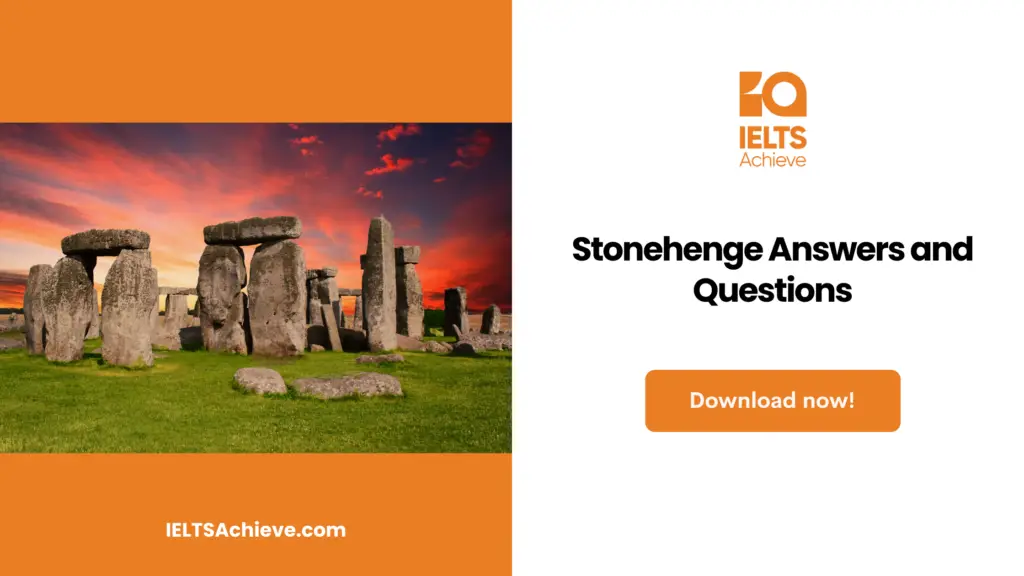The Blog post contains the following IELTS Reading Questions:
- IELTS Reading Diagram labelling
- IELTS Reading Multiple choice questions.
Stay informed and prepared for success – Explore our comprehensive Reading Test Info page to get valuable insights, exam format details, and expert tips for mastering the IELTS Reading section.
IELTS Reading Passage – Stonehenge

Stonehenge
Approximately two miles west of Amesbury, Wiltshire, in southern England stands Stonehenge, one of the world’s most famous megalithic monuments. The remains of Stonehenge consist of a series of stone structures arranged in layers of circular and horseshoe-lie patterns. Theories and myths concerning this mysterious monument have flourished for thousands of years. The Danes, Egyptians, and Druids are just a few of the groups who have been credited with building Stonehenge. Some people have even made attempts to prove that aliens erected Stonehenge. Early historians believed that the monument was constructed as a memorial to nobleskilled In combat, while other later theorists described Stonehenge as a place for sacrificial ceremonies. Regardless of who but the monument and why all of the legends surrounding these megaliths are based on speculation. With the exception of archaeological evidence, very little of what we understand about Stonehenge today can actually be called fact.Stonehenge was constructed in three phases during the Neolithic and Bronze Age periods. Stonehenge period 1, also commonly referred to as Phase 1, Is believed to have occurred sometime around 3000 B.C. during the middle Neolithic period. In this first step of the construction, picks made of deer antlers were used to dig a series of 56 pits. These pits were later named “Aubrey Holes” after an English scholar. Outside of the holes wasdug a large circular henge (a ditch with an earthen wall). During this phase, a break, or entranceway was also dug on the northeast corner of the henge. Archaeologists today refer to this break as the Avenue. Two stones were set on the Avenue. The “Slaughter Stone” was placed just inside the circle, while the “Heel Stone” was placed 27 meters down the Avenue. The Heel Stone weighs about 35 tons and is made of natural sandstone, believed to haveoriginated from Marlborough Downs, an area 20 miles north of the monument.
The 35-foot-wide Avenue is set so that, from the center of Stonehenge, a person would be able to see the sunrise to the left of the heel stone. Just inside the henge, four other “Station Stones” were placed in a rectangular formation.There is great debate over how long the first phase of Stonehenge was used and when the original alterations were made; however, the second phase is generally placed between 2900 B.C. and 2400 B.C. and accredited to the Beaker people. It is thought that many wooden posts were added to the monument during this phase. One of the problems archaeologists have had with Phase 2 is that unlike stone or holes in the earth, Wood does not hold up over thousands of years. The numerous stake holes in the earth tell the story of where these posts were positioned. Besides the ones in the center of the henge, six rows of posts were placed near the entrance. These may have been used to mark astronomical measurements, or to guide people to the center. The original Aubrey holes were filled in either with earth or cremation remains. Many archaeologists believed that the Beaker people were sun worshipers and that they may have purposely changed the main axis of the monument and widened the entrance during this phase in order to show their appreciation for the sun.The final phase of Stonehenge is usually described in terms of three subphases, each one involving a set of large stones. The first stones that arrived were bluestones, brought all the way from the Preseli Hills in Pembrokeshire, Wales.
A horseshoe of paired bluestones was placed in the center of the henge, with a tall Altar Stone marking the end of the formation. In the next subphase, a 30-meter ring of sandstones called the Sarsen Circle was built around the bluestone. Only 17 of the original 30 stones remain. These sarsen stones were connected with lintel blocks, each precisely carved in order to fit end-to-end and form perfectly with the stone circle. Approximately 60 more bluestones were then added inside the original horseshoe.How these enormous stones were transported and raised in Phase 3 remains a mystery. The fact that these monoliths were built before the wheel means an incredible amount of manual labor was used. It is believed that a pulley system using rollers still would have required at least one hundred men to operate. Raising the lintels and fitting them into one another would have been another major struggle without the use of machines. Stonehenge remains one of the world’s greatest mysteries and one of England’s most important icons.
Unlock your full potential in the IELTS Reading section – Visit our IELTS Reading Practice Question Answer page now!
Recommended Questions:
Renewable Energy IELTS Reading Question with Answer
Stonehenge Reading Questions
QUESTIONS 1-4
Complete the diagram of Stonehenge below. Choose your answers from the list below and write letters, A-F, in boxes 1-4 on your answer sheet. NB There are more letters than spaces, so you will not use them all.
List of answers
A Aubrey Holes
B HeelStone
C Marlborough Downs
D Avenue
E Henge
F Station Stones

1. ………………………..
2. ………………………..
3. ………………………..
4..……………………..
Ready to tackle Diagram Label Completion tasks with confidence? Click here to access our comprehensive guide and learn how to accurately label parts or components of diagrams in the IELTS Reading section.
QUESTIONS 5-13
Which phase did the following things occur? Choose the correct letter, A-C, and write it in boxes 5-13 on your answer sheet.
List of phases
A If it occurred during Phase 1
B If it occurred during Phase 2
C If it occurred during Phase 3
5. The entrance was made wider.
6 .The Slaughter Stone was erected.
7. Stones were placed in a horseshoe formation.
8. Wooden posts were set near the entrance.
9. Deer antlers were used to dig holes.
10. Bluestones were brought from a distant location.
11. A ring of sandstones was constructed.
12. Holes were filled with dirt.
13. The Altar Stone was erected.
Ready to improve your performance in Multiple Choice Questions (MCQs)? Click here to access our comprehensive guide on how to tackle MCQs effectively in the IELTS Reading section.
Unlock your full potential in the IELTS Reading section – Visit our IELTS Reading Practice Question Answer page now!
Recommended Questions:
Renewable Energy IELTS Reading Question with Answer
Stonehenge Reading Answers
1. Answer: E
2. Answer: A
3. Answer: D
4. Answer: B
5. Answer: B
6. Answer: A
7. Answer: C
8. Answer: B
9. Answer: A
10. Answer: C
11. Answer: C
12. Answer: B
13. Answer: C

We hope you found this post useful in helping you to study for the IELTS Test. If you have any questions please let us know in the comments below or on the Facebook page.
The best way to keep up to date with posts like this is to like us on Facebook, then follow us on Instagram and Pinterest. If you need help preparing for the IELTS Test, join the IELTS Achieve Academy and see how we can assist you to achieve your desired band score. We offer an essay correction service, mock exams and online courses.

